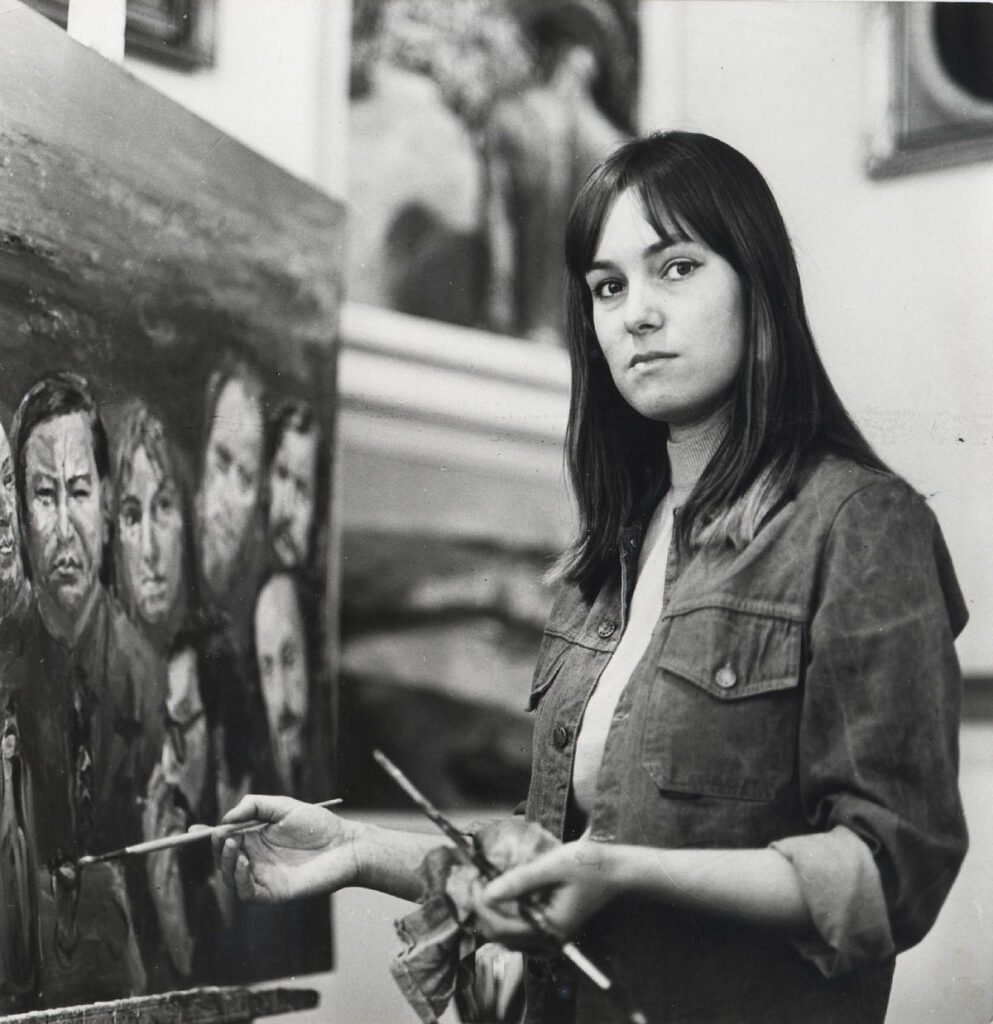The painter Gudrun Brüne died on 25 January 2025 at the age of 83 in Neuruppin after a long illness. With her art, which is characterised by clear, allegorical depictions, cross-generational themes and deep social reflection, she remains an artist of immense, timeless relevance. Gudrun Brünes’ paintings, in which masks, dolls and metaphorical scenes are figuratively depicted, revolve around central questions of human existence: love, transience, manipulation, self-determination, destruction and the search for true identity. These themes, which constitute the fundamental questions of her art, probably also arose from the formative experiences in her life.
Image above: Gudrun Brüne in her studio in Strodehne in Havelland, 1992 © Gudrun Brüne Estate
Gudrun Brüne was born in Berlin in 1941. At the age of just two, she lost her father, who died on a submarine mission during the Second World War. Together with her mother and sister, she was evacuated to a place near Bremen. In 1947, the family moved to Leipzig, where Gudrun Brüne grew up. At the end of the 1950s, she completed an apprenticeship as a bookbinder in Pößneck, Thuringia. From 1961 to 1966, she studied under Heinz Wagner and Bernhard Heisig at the Hochschule für Grafik und Buchkunst (Academy of Visual Arts) in Leipzig, graduating with a diploma. The influential impact of these teachers was reflected in her later work. At the same time, she succeeded in finding an unmistakable painterly style. From 1966 to 1977, Gudrun Brüne worked as a freelancer and occasionally in the studio of her future husband Bernhard Heisig. She presented her first solo exhibition in Leipzig in 1973.

From 1974 to 1982, Brüne was a member of the painters/graphic artists section of the Verband Bildender Künstler der DDR (Association of Visual Artists of the GDR), which further consolidated her position in the art scene. From 1977, she took on the role of an assistant and from 1979 to 1999 taught as a lecturer in painting and graphics and head of a specialised class at the Hochschule für Kunst Burg Giebichenstein (Burg Giebichenstein University of Art). In 1988, Gudrun Brüne’s paintings were shown at the Venice Biennale and ten years later at Art Cologne. She has been honoured several times, including the Kunstpreis der DDR (GDR Art Prize) in 1987 and the Verdienstmedaille der DDR (GDR Medal of Merit) in 1981. Her works, which were mainly exhibited in the GDR during the period of German division, also attracted attention in West German galleries and in Chicago after the fall of the Wall.
Gudrun Brüne was one of the few female artists to gain recognition in the male-dominated Leipzig School and whose work is characterised not only by technical skill, but also by emotional depth and symbolic power. Her paintings, which are characterised by a clear, figurative style, focus on the timeless themes of humanity. Both the veiling masks and the dolls, which are predominantly depicted as individual objects or piled up into mountains of damaged corpses or fragmented body parts, are recurring leitmotifs in her work. They symbolise the inscrutable, the façade, the split between an intact world and the confrontation with destruction, which was particularly resonant in the 1980s. Gudrun Brüne put it this way in an interview in 1988: ‘There is a certain fascination with the destroyed dolls. They awaken people’s feelings and thoughts in very different ways. That pleases me. I believe that the dolls trigger more consternation than the reality of destruction that comes into our rooms every day through television, for example. The combination of a perfect world, which the doll symbolises, and destruction sets people’s minds in motion.’
Gudrun Brüne and Bernhard Heisig had a special bond with former German Chancellor Helmut Schmidt and his wife Loki. In 1985 – four years before the fall of the Berlin Wall – Schmidt had decided that not a West German artist, but the GDR painter Bernhard Heisig should create his portrait for the so-called Chancellor’s Gallery. And so it happened the following year. A friendship developed from this encounter. Years later, Gudrun Brüne painted a portrait of Loki Schmidt, with a floating wreath of flowers above the head of the passionate botanist. Gudrun Brüne said: ‘In the first version of the painting, Helmut Schmidt thought his wife looked a little depressed. He thought that wouldn’t be appropriate for her, as she was more of an optimistic type. I then produced a new version. Helmut Schmidt saw it years later, after Loki’s death, in my studio. He had probably forgotten about the painting, stopped in front of it in his wheelchair in amazement and said: ‘Oh, that’s Loki’. He later wrote to me saying that he would like to have the picture.’

Since 1991, Gudrun Brüne lived and worked with her husband Bernhard Heisig in Strodehne in Havelland, a place, she said, that was known at the time as the ‘Worpswede of the East’. The couple worked side by side for over twenty years in a specially built double studio. Bernhard Heisig died in 2011. Gudrun Brüne remained in Strodehne.
Gudrun Brüne was not only an artist, but also a woman who faced the challenges of her time with courage. In an artistic partnership that lasted over 50 years, she stood by the side of her husband Bernhard Heisig, one of the most famous painters of the former GDR. Despite the weight of his fame, she managed to find her own artistic voice, which became increasingly clear over the years. Her work and her life are inextricably linked to the history of the Leipzig School and the German art scene of the 20th century. The painter created a large number of works over a period spanning from the early 1960s to the end of 2024. Her life’s work comprises more than 600 paintings and drawings.
Anyone who knew Gudrun Brüne was impressed by her discipline, diligence and focus. Painting dominated her daily life. Until the end, she worked on new works in her studio in Strodehne with her characteristic demand for technique and perfection, regardless of her diminishing strength.
Gudrun Brüne’s death leaves a significant gap, but her work remains alive and timeless. It continues to challenge us to reflect on our own humanity and the world we are shaping. She will be remembered as one of the most influential artists of her time.
We will miss Gudrun very much and mourn with her family and all those who were close to her.
Text: Stephanie Schneider






